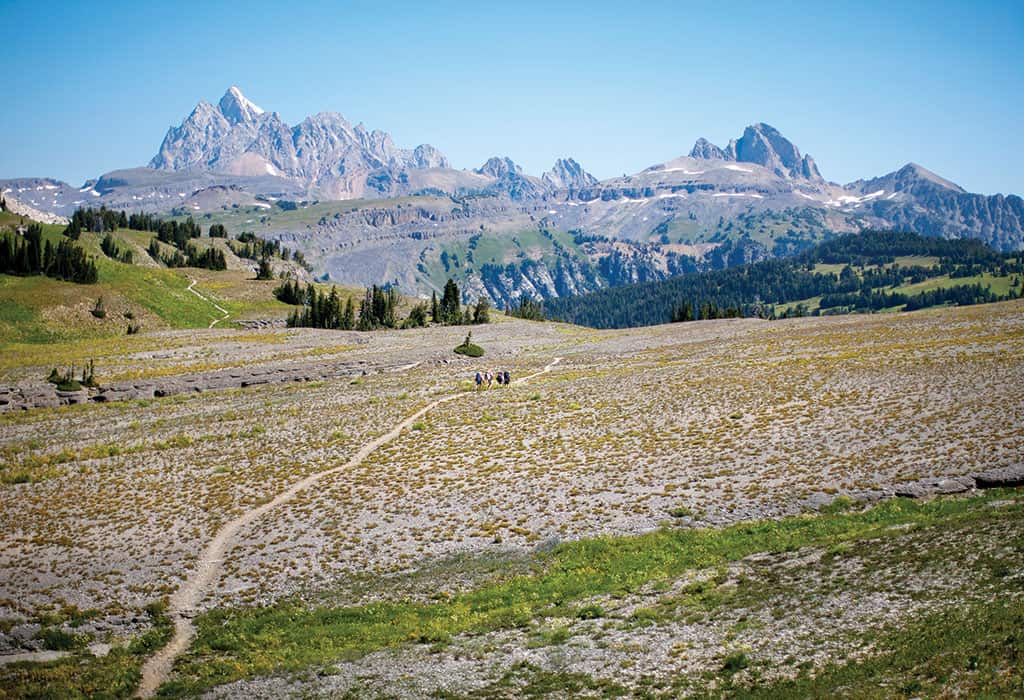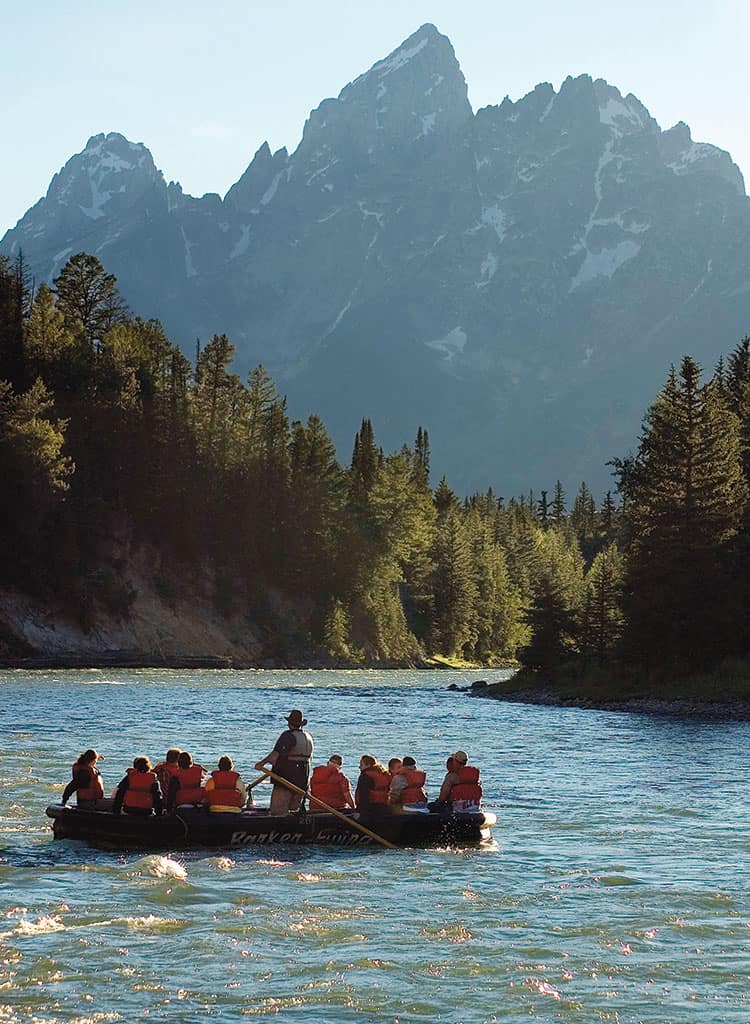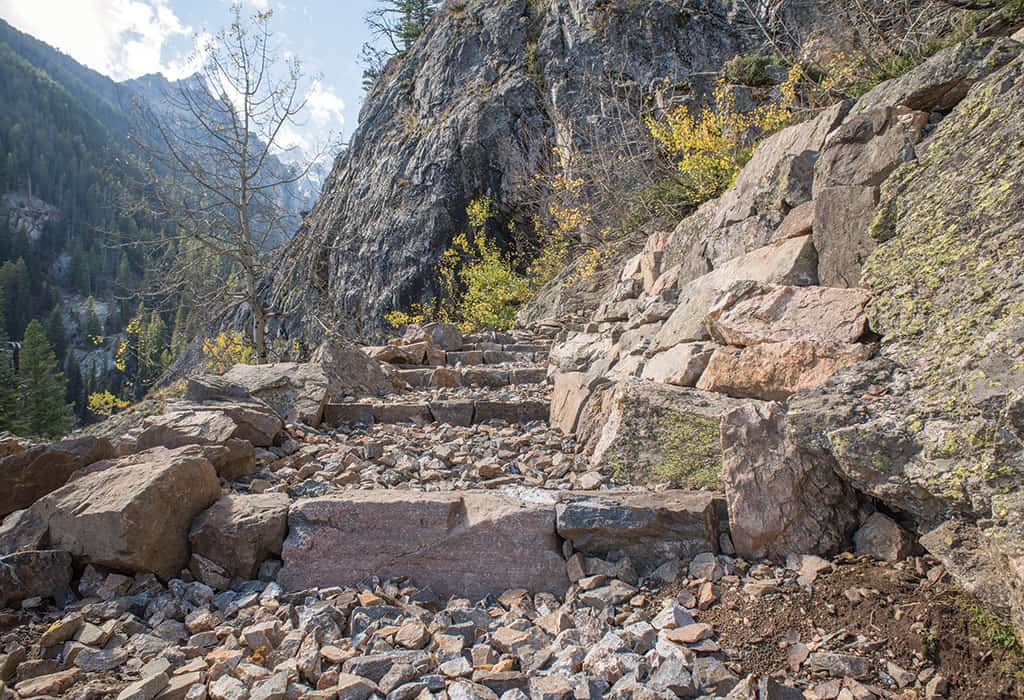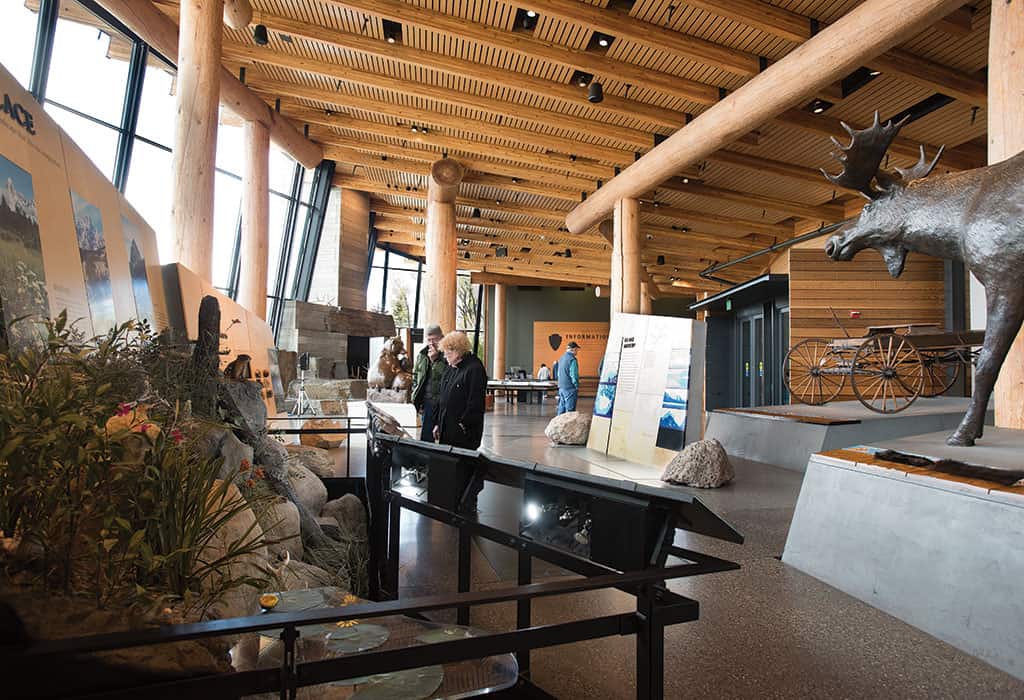Read The
Current Issue
Park Players
Mother Nature made Grand Teton National Park, but it’s a team effort—with the 100-year-old National Park Service playing quarterback—that keeps the park looking its best.
By dina mishev

Grand Teton National Park (GTNP) was established by Congress in 1929, but it was not founded as the national park we know today. The original footprint included the Teton Range itself and only six glacial lakes at the foot of the range: Jackson, Leigh, Jenny, Bradley, Taggart, and Phelps lakes. Elsewhere around the base of the range were commercial enterprises, dude ranches, and unchecked development.
John D. Rockefeller Jr., who previously had been active in Maine’s Acadia National Park—financing, designing, and directing the construction of a network of carriage trails throughout it—first visited the Tetons in 1926. At this time the range was not yet a national park. Rockefeller came to the Tetons with Horace Albright, the superintendent of Yellowstone National Park, which Congress founded fifty-four years prior. Although GTNP wasn’t yet established, Albright knew the area under consideration. Rockefeller recognized that it was a larger area than planned that deserved protection, but to enlarge the park was problematic because the land around the base of the range was private property. For this land to be included in the park, it would have to be bought and reclaimed.
The same day he toured the Tetons with Yellowstone’s superintendent, Rockefeller asked Albright to compile a list of the properties that would have to be purchased to protect the entire area he envisioned as GTNP.
According to the Grand Teton National Park Foundation, “By 1933, Rockefeller and his agents, under the name the Snake River Land Company, had purchased over 35,000 privately held valley acres.” This caused great controversy in Jackson Hole, but that is another story (check in with the Jackson Hole Historical Society if you want to know more). It took over a decade, and an executive order by President Franklin D. Roosevelt, though, for the U.S. government to accept Rockefeller’s gift of these acres.
When Roosevelt did sign the executive order accepting Rockefeller’s donation, the land was not immediately added to GTNP, but made the Jackson Hole National Monument. It wasn’t until 1950 that the monument and the 1929 park were combined to create the GTNP we know today. What better time than the one hundreth anniversary of the National Park Service (NPS) to take a look at the national park that is the heart and soul of Jackson Hole?

Five WAYS TO CELEBRATE Grand Teton National Park THIS SUMMER
1 Scenic Float Along the Snake River
Guided raft trips start at Deadman’s Bar, about twenty minutes north of Moose. Pushing off into the fast current, you won’t have to wait long to gawk at the Cathedral Group; it’s around the first corner. Scan the cottonwoods along the river for bald eagles. The Snake River through Jackson Hole has one of the country’s densest populations of the once-endangered bird. You might also see common goldeneyes (a duck not spotted too often), osprey, beaver, elk, moose, and sandhill cranes. From $70, 307/733-1800, barkerewing.com
2 Camp by Kayak
If all you do is admire Jackson Lake, one of the deepest and largest high-altitude lakes in the country, from a lookout along its eastern shore, there’s nothing wrong with that. But if you’re an experienced kayaker, have a more intimate excursion—and a more unique one—by camping on Elk Island, the largest of the fifteen islands in the lake, or on the lake’s wild western shore, both of which are only accessible by boat. Motorboats are an option, too. GTNP requires all boats to register for a permit. For nonmotorized craft, the fee is $10 for a 7-day permit and $20 for an annual permit. Info: nps.gov/grte/planyourvisit/boat.htm. Grand Teton Lodge Company and Signal Mountain Lodge both rent canoes and sea kayaks.
3 Summit Table Mountain
Table Mountain is not itself in Grand Teton National Park, but has some of the best views of the Grand. “You don’t have to be in Grand Teton National Park to enjoy Grand Teton National Park,” says GTNP acting public affairs officer Andrew White. “You can be so many other places nearby and have an incredible Teton experience.”
After climbing 4,100 vertical feet over almost seven miles—this is a challenging hike; the round-trip is close to fourteen miles—you’ll reach a flat, large summit from which you’ll feel like you can touch the Grand Teton. This trailhead starts from the Teton Campground, at the end of Teton Canyon Rd., which is off of Ski Hill Rd. in Driggs, Idaho. There is no fee to access this trailhead or hike.
4 Teton Crest Trail/Alaska Basin
Grand Teton National Park has upwards of three hundred miles of trails. The forty-some miles that are the Teton Crest Trail are the most iconic. It traverses the Death Canyon Shelf, crosses Alaska Basin, and passes Marion, Sunset, Solitude, and Holly lakes. The trail hovers at an elevation of about 10,000 feet, although it does reach nearly 11,000 feet in two spots. Backcountry camping permits are $25 at the park and $35 online; camping in the wilderness is free. nps.gov/grte/planyourvisit/bcres.htm
5 Oxbow Bend at Sunrise
It was from the Snake River Overlook, about four miles north of Moose, that Ansel Adams took his famous The Tetons and the Snake River image in 1942. That spot remains popular with photographers, but Oxbow Bend, several miles from the park’s Moran entrance, is even more so. Behind a giant bend in the Snake River is massive Mount Moran and its distinctive Skillet Glacier, which, impossibly steep as it looks, lures extreme skiers. Ensure you get the best reflection of the mountains on the river by going early in the morning, before winds kick up.

JENNY LAKE GETS A MAKEOVER
THERE’S REALLY NO other way to say it, so GTNP chief of facility management Chris Finlay doesn’t mince words: “South Jenny Lake is going to be a pretty unpleasant place this summer.” Hidden Falls is closed the whole season due to construction, and equipment occupies one-third of the space in the already-overflowing South Jenny Lake parking lot.
But, come back in late summer 2017 and you’ll have the most pleasant Jenny Lake experience a visitor has had in several decades. That is when the “Inspiring Journeys” project, an $18 million-plus, public/private partnership between GTNP and the GTNP Foundation—and its four years of construction—will be finished. The project involves redoing pretty much the entire Jenny Lake area, including everything from bathrooms to the boat dock, front- and backcountry trails, overlooks, and retaining walls.
This revamping of Jenny Lake is meant to ensure park visitors will be able to enjoy this special area for the next one hundred years, and also that this special area will be able to survive visitors for the next one hundred years. “We’re hoping for a lifespan of seventy-five to one hundred years for these improvements,” says GTNP landscape architect Matt Hazard.
“We realize this is a huge financial commitment and project, but there is such enormous love for this place—so many people have told me they’ve had life-changing experiences in Grand Teton National Park or at Jenny Lake, or that they think Jenny Lake is the most beautiful place they’ve ever seen,” says GTNP Foundation President Leslie Mattson. The foundation is funding $14 million of the project. “We’ve been very successful [with fundraising] because people love this park and because we have a great project. People can see Jenny Lake needs some help.”
IT’S GOOD TO HAVE FRIENDS
Meet the Grand Teton National Park Foundation
Do you wonder how GTNP managed to hire Bohlin Cywinksi Jackson, the architecture firm behind many Apple retail stores around the world, to design its 22,000-square-foot Craig Thomas Discovery and Visitor Center in a time of budget cuts? Meet the GTNP Foundation, a private, 501(c)(3) nonprofit organization whose mission is to fund projects that enhance the park’s cultural, historic, and natural resources. The group was founded in 1997 at the behest of then-superintendent Jack Neckles. “He really wanted to see a new visitor center in the park,” says foundation president Leslie Mattson.
The Craig Thomas Discovery and Visitor Center opened in 2007. Unofficially, it’s the best-looking and best-designed, most educational, and overall awesome visitor center in any national park in the country. This awesomeness didn’t come cheap, however: It cost a total of $24.8 million, including a $3.2 million high-definition theater and auditorium. The $21.6 million first phase was funded from an $8 million congressional appropriation and $13.6 million in private-sector gifts. The latter came from the foundation.
“Former park superintendent Mary Scott told us that without the foundation’s help, they [the park] would have been able to build a glorified bathroom,” Mattson says. “The foundation never wants to take the place of the federal government. Our goal is to leverage public and private money to make the park the best it can be. We’re helped in doing this by having such a strong partnership with the park. We’re truly collaborators.”
Foundation projects also include the placement of bear-resistant food storage lockers throughout park campgrounds, grizzly bear research and conservation, and the Youth Conservation Program. Through the latter, which began in 2006, 193 sixteen- to nineteen-year-old students have contributed nearly 67,000 hours of work to improve trail access, protect fragile habitat, and preserve historic sites in the park. To date, the foundation has raised more than $40 million for these and other projects. gtnpf.org

ARE WE LOVING OUR PARKS To Death
IT TURNS OUT that GTNP, like most every other national park, is being visited and loved to death. It has a $216 million backlog of maintenance projects. Sadly, Yellowstone’s backlog is multiples of this. Add up the maintenance projects across the 410 areas of the NPS and the backlog is $12 billion, about 175 percent of the state of Wyoming’s annual budget. Last year a record 305 million people traveled from across the country and around the world to spend time in a national park. To put this figure in perspective, in 2015 more people visited a national park than attended every single Major League Baseball, National Football League, and National Basketball League game, NASCAR race, and Disney theme park … combined.
“At some national parks in peak seasons there are so many visitors trying to see the same special sight or do the same activity at the same time, there is crowding and disappointment by visitors,” says Joan Anzelmo, who moved to Yellowstone National Park in 1980 and subsequently spent a large portion of her adult life living and working in Yellowstone and Grand Teton national parks before going on to serve as superintendent of Colorado National Monument and also as the NPS’ national spokesperson in Washington, D.C. “There can also be negative impacts to the fragile natural and cultural resources, depending on the specific park.”
Grand Teton National Park had a record year for visitation in 2015; for the first time the park received more than 4.6 million visitors, an 8 percent increase over 2014. It can be difficult to find a parking space, or even space to park your bike, at South Jenny Lake. Lines to take the Jenny Lake boat shuttle to the lake’s western shore can be over an hour long. Permits to camp in the park’s backcountry, necessary for those hiking the Teton Crest Trail or climbing the Grand Teton, among other activities, are challenging to obtain. If you do manage to snag a permit to camp along the route up the Grand, “then the climb is a crowded experience most of the time,” says Anzelmo, who returned to live in Jackson Hole after retiring from the NPS and today serves as a national park advocate and member of the Coalition to Protect America’s National Parks. “That diminishes the experience, impacts the fragile alpine terrain, and can add safety concerns.”
In 1997 Zion National Park, in southern Utah, established a shuttle system along Zion Canyon Scenic Drive; between mid-March and October, the only access to this road is via public shuttle. Bryce Canyon National Park, also in southern Utah, instituted optional shuttles over a decade ago. You can still drive your own car into the park, but it costs an additional fee. Neither GTNP nor Yellowstone has yet established any driving or visitor limitations, but it might be time for the parks, and the NPS as a whole, to think about bringing these policies, especially visitation, into the twenty-first century.
Today it is usual to reserve tickets for movies in advance, just as we do with concerts and sporting events—why not do the same at the most popular national parks, in peak times and at certain locations? “If visitation is not limited at some parks in peak season at its busiest locations, the experiences will be very diminished for visitors,” Anzelmo says. “Of even greater concern is the park resources that people are flocking to see will be so negatively impacted that they could be ruined forever. Increasing visitation for the most popular national parks is simply not sustainable. There needs to be some limits placed on visitor numbers so that the parks will continue to be there for everyone to experience.”

Q & A: Matt Hazard
Grand teton national park Landscape Architect
As soon as landscape architect Matt Hazard saw an open position in his field in GTNP, he applied. “If I got it, I was moving to the Tetons without question,” says the thirty-five-year-old. Hazard started at the park in June 2010, after several years working at a private firm in California. “The private sector is about the bottom line,” he says. “The NPS is more about protecting the resource—I get more satisfaction out of it.” Shortly after his arrival in Jackson Hole, Hazard was presented with arguably one of the most intimidating landscape architecture projects in the whole NPS: a revamping of the entire Jenny Lake area. Jenny Lake, in the southern part of GTNP, is the single most visited spot in the park. About 1.9 million of the park’s 4.6 million-plus annual visitors stop at South Jenny Lake.
Minor repairs had been done to its frontcountry and backcountry trails in the last several decades, but, “The resource was really suffering,” Hazard says. So Hazard was put in charge of the team responsible for the renewal, which has been under construction since summer 2013 and is slated to be finished in summer 2017. We pulled Hazard out of his office—a construction trailer in the South Jenny Lake parking lot—to tell us about his time in GTNP.
Q: Why did you know you wanted to work at GTNP?
A: I came here with my family in the 1990s. I grew up in Mississippi, but my parents always dragged us on family trips out West. I remember hiking down to Phantom Ranch [in the Grand Canyon] when I was eleven. These early trips gave me an appreciation of the landscapes of the West.
Q: Did you visit Jenny Lake on that trip?
A: Yup. We hiked around it as a family.
Q: What were your thoughts when you hiked around it with the eyes
of a landscape architect?
A: Wow, this needs a lot of work. I saw we’d really have to touch every linear foot of trail. Also, I got confused on where to start. It was hard to get my bearings.
Q: When you began work on the renewal plans, what were the goals?
A: Curbing erosion, making trails safer, protecting the resource, and making it less confusing for first-time users. We realized there were redundant trails.
Q: Was the original plan to do the whole area?
A: No. We triaged the worst areas, and, working with the trail crew, I came up with a plan of what to fix first. But then the GTNP Foundation came in with very generous support, and we were able to tackle much more than expected.
Q: What should people expect this summer?
A: Unfortunately, Hidden Falls is going to be closed, but the improvements we’ll be doing there are much needed. Inspiration Point will be open.
Q: Is there another waterfall people can visit in lieu of Hidden Falls?
A: Several hundred feet from the west shore boat dock, at the spot we now call “confusion junction,” there is a great cascade. Lots of people actually come to that area and think it is Hidden Falls. We had to put up a sign saying that it is not Hidden Falls.
Q: Off-duty, where do you go hiking?
A: Moose Basin, across Jackson Lake, and Upper and Lower Berry canyons. Some of the geological formations up there are unreal. And there are no people.
Q: The trails over there are pretty primitive.
A: I like exploring and the feeling I get when I’m not 100 percent sure of where I am. It makes for an adventuresome trip.
Q: But signs can be good, right?
A: Yes. We want people to have a good experience and you can’t if you’re wondering where you are. As the renewal is going on, at each intersection there will be a “You Are Here” sign. But when the project is finished, the idea is that trail alignments will be more intuitive, so that we can keep signage to a minimum and there is not as much visual clutter in the backcountry.
Q: Since we’re talking mostly about dirt trails, why is redoing Jenny Lake so expensive?
A: When you hike on a trail, you’re not seeing everything that is below. Sometimes it is just dirt, but other times, to prevent or fix erosion, there’s twelve inches of crushed rock underneath your feet. The dry stone walls we’re building require true craftsmen, too. All of the trail crew are dry stone masons. When the project is done, there will be over 1,000 linear feet of dry stone wall that we’ve constructed, and five miles of trail treads serviced.
Q: What are you going to do in 2017, when this project is finished?
A: The park is taking a look at String Lake. It needs a lot of attention.




